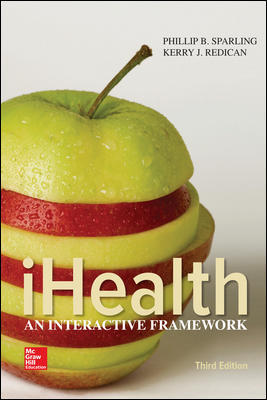Test Bank For iHealth 3rd Edition By By Phillip Sparling
Digital item No Waiting Time Instant DownloadBy Phillip Sparling and Kerry RedicanISBN10: 1260241076ISBN13: 9781260241075Copyright: 2021
In Stock
Original price was: $55.00.$29.00Current price is: $29.00.
Test Bank For iHealth 3rd Edition By By Phillip Sparling
Chapter 03
Develop A Fitness Program
Multiple Choice Questions
1. Flexibility is the functional range of motion in a _____.
A. muscle group
B. tendon
C. bone
D. joint
Accessibility: Keyboard Navigation
Bloom’s Taxonomy: Knowledge
Learning Objective: Define flexibility
Topic Area: Recommendations for Healthy Adults
2. Many of the chronic diseases we face today are associated with _____.
A. a sedentary lifestyle
B. alcohol abuse
C. poor nutrition
D. drug abuse
Accessibility: Keyboard Navigation
Bloom’s Taxonomy: Knowledge
Learning Objective: Identify health problems related to physical inactivity
Topic Area: Physical Activity, Exercise, and Physical Fitness
3. In which of the following decades of life can disease of inactivities, such as osteoporosis and heart disease, begin to take effect?
A. First and second decades
B. Second and third decades
C. Third and fourth decades
D. Fourth and fifth decades
Accessibility: Keyboard Navigation
Bloom’s Taxonomy: Knowledge
Learning Objective: Know when diseases of inactivity begin to take effect
Topic Area: Physical Activity, Exercise, and Physical Fitness
4. Simply put, physical activity refers to:
A. moving around using the body’s muscle power.
B. training for an upcoming event.
C. being athletic.
D. maintaining a high level of fitness and well-being.
Accessibility: Keyboard Navigation
Bloom’s Taxonomy: Knowledge
Learning Objective: Define physical activity
Topic Area: Physical Activity, Exercise, and Physical Fitness
5. Consistently incorporating physical activity into one’s life yields:
A. some health benefits.
B. minimal health benefits.
C. significant health benefits.
D. significant weight loss.
Accessibility: Keyboard Navigation
Bloom’s Taxonomy: Knowledge
Learning Objective: Recall the benefits of physical activity
Topic Area: Physical Activity, Exercise, and Physical Fitness
6. Physical fitness is defined as:
A. the ability to carry out daily tasks with vigor and alertness.
B. structured physical activity focused on improving physical capacity.
C. physical effort based on heart rate.
D. muscular movement that results in significant energy expenditure.
Accessibility: Keyboard Navigation
Bloom’s Taxonomy: Knowledge
Learning Objective: Define physical fitness
Topic Area: Physical Activity, Exercise, and Physical Fitness
7. Structured physical activity that is focused on improving or maintaining physical capacity is called:
A. specific sport training.
B. exercise.
C. ballistic stretching.
D. physical fitness.
Accessibility: Keyboard Navigation
Bloom’s Taxonomy: Knowledge
Learning Objective: Define exercise
Topic Area: Physical Activity, Exercise, and Physical Fitness
8. A person’s physiological well-being _____ as their fitness level improves.
A. declines
B. improves
C. stays the same
D. fluctuates
Accessibility: Keyboard Navigation
Bloom’s Taxonomy: Knowledge
Learning Objective: Describe the three aspects of physical fitness
Topic Area: Physical Activity, Exercise, and Physical Fitness
9. Which three components does health-related physical fitness include?
A. Cardiorespiratory fitness, musculoskeletal fitness, and body composition
B. Muscular strength, muscular endurance, and flexibility
C. Body composition, muscular strength, and muscular endurance
D. Cardiorespiratory fitness, flexibility, and muscular endurance
Accessibility: Keyboard Navigation
Bloom’s Taxonomy: Knowledge
Learning Objective: Construct a model of physical fitness and its three components
Topic Area: Physical Activity, Exercise, and Physical Fitness
10. Musculoskeletal fitness increases bone density, muscle mass, and joint health and thereby lowers the risk of _____.
A. heart attack
B. type II diabetes
C. stroke
D. osteoporosis
Accessibility: Keyboard Navigation
Bloom’s Taxonomy: Knowledge
Learning Objective: Relate musculoskeletal fitness to bone and joint health
Topic Area: Physical Activity, Exercise, and Physical Fitness


Reviews
There are no reviews yet.